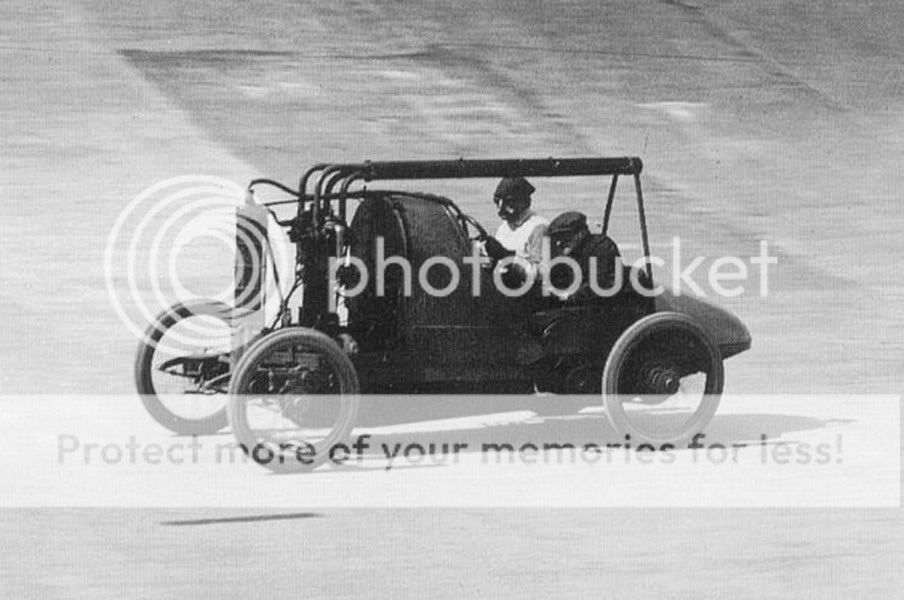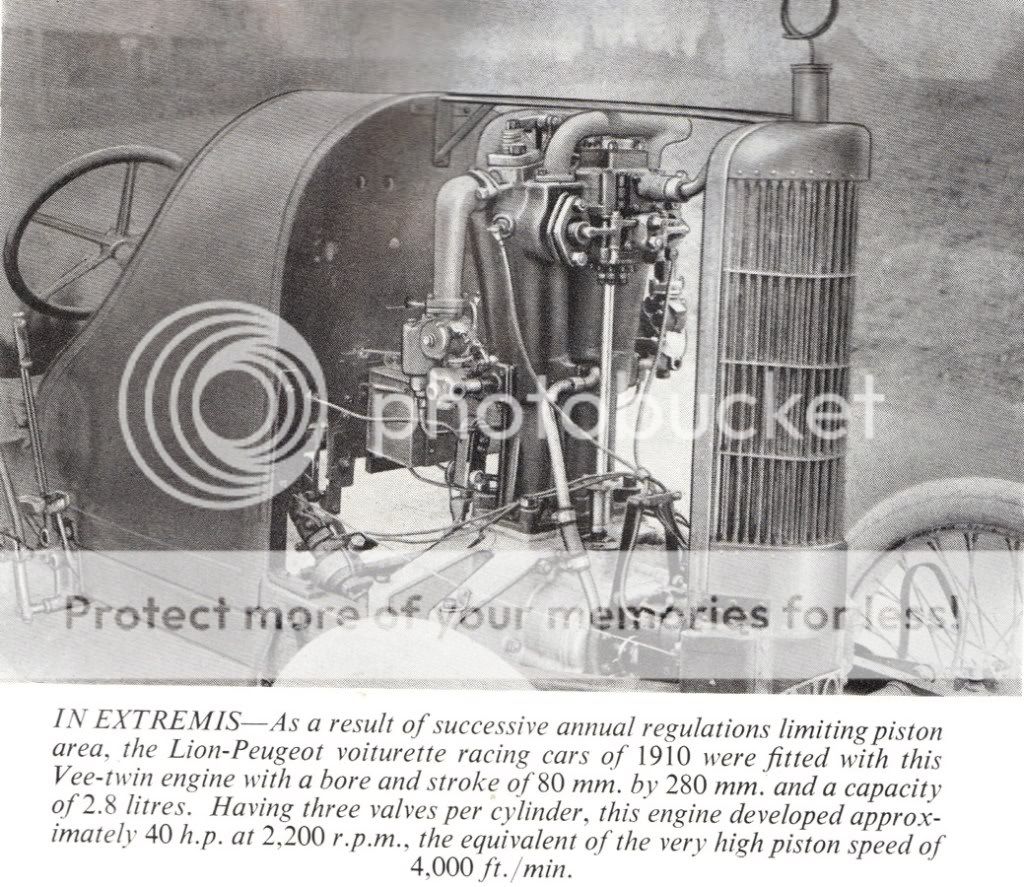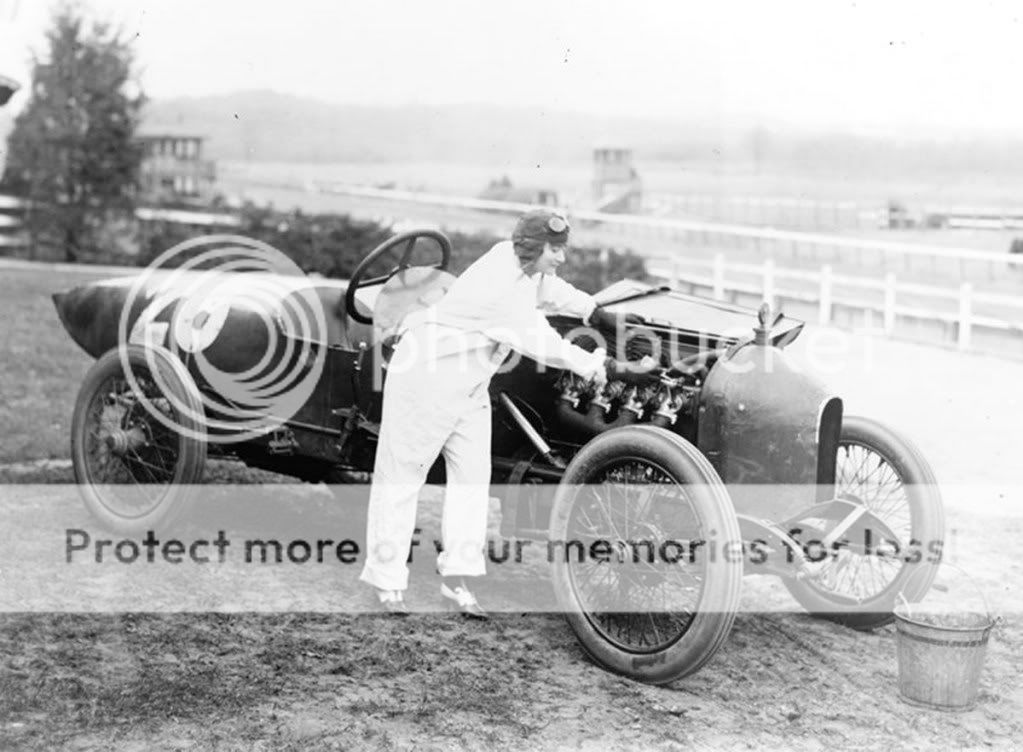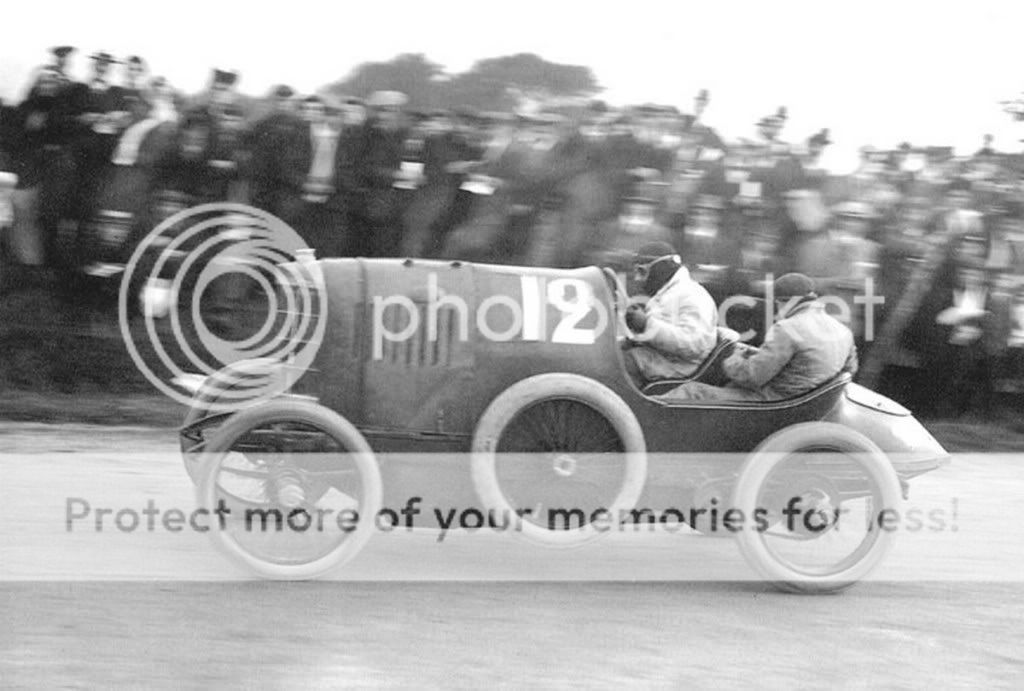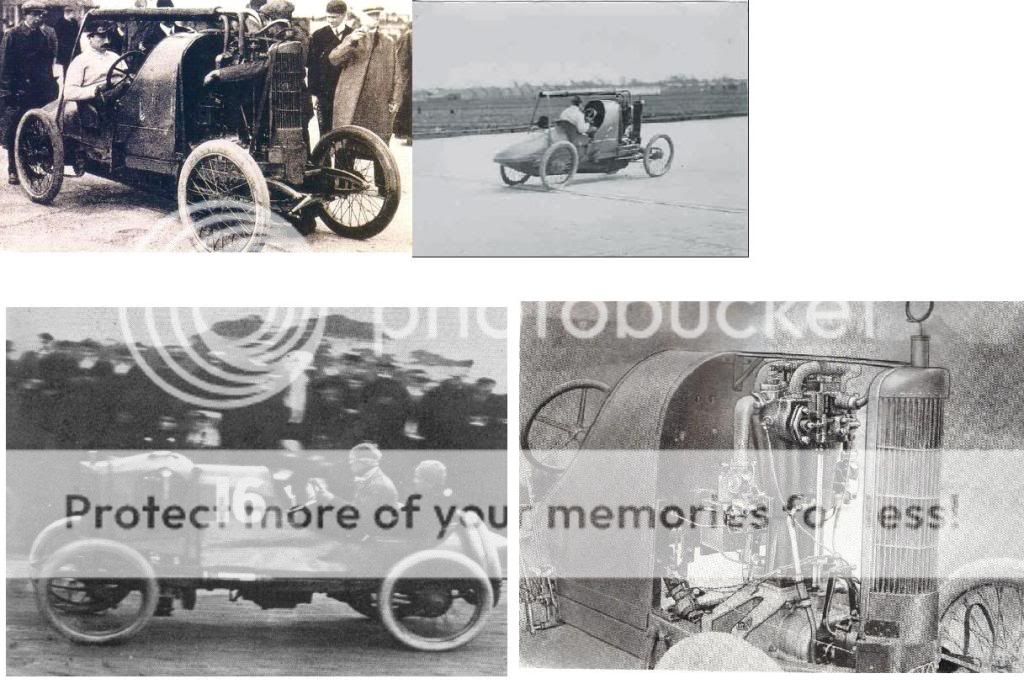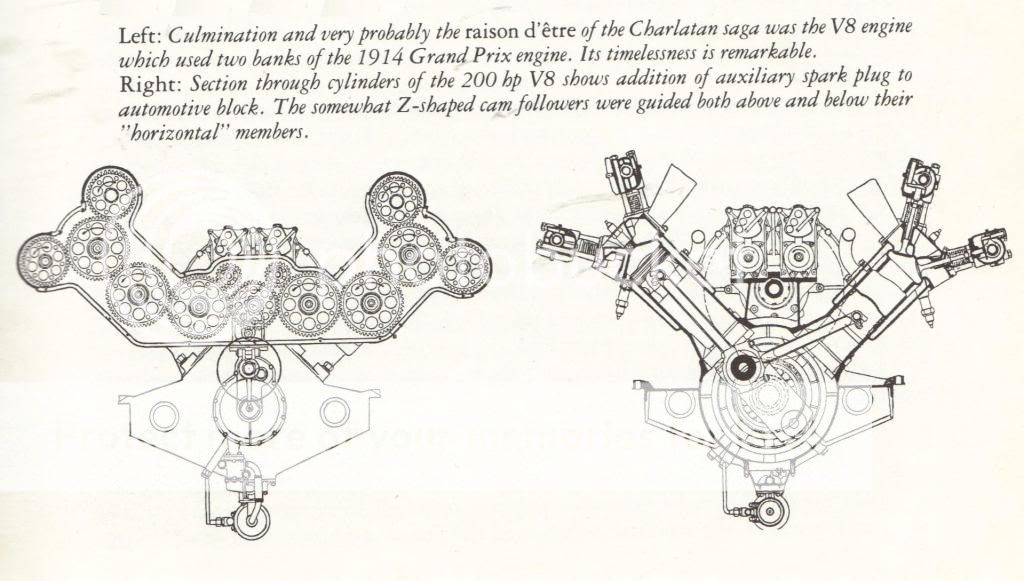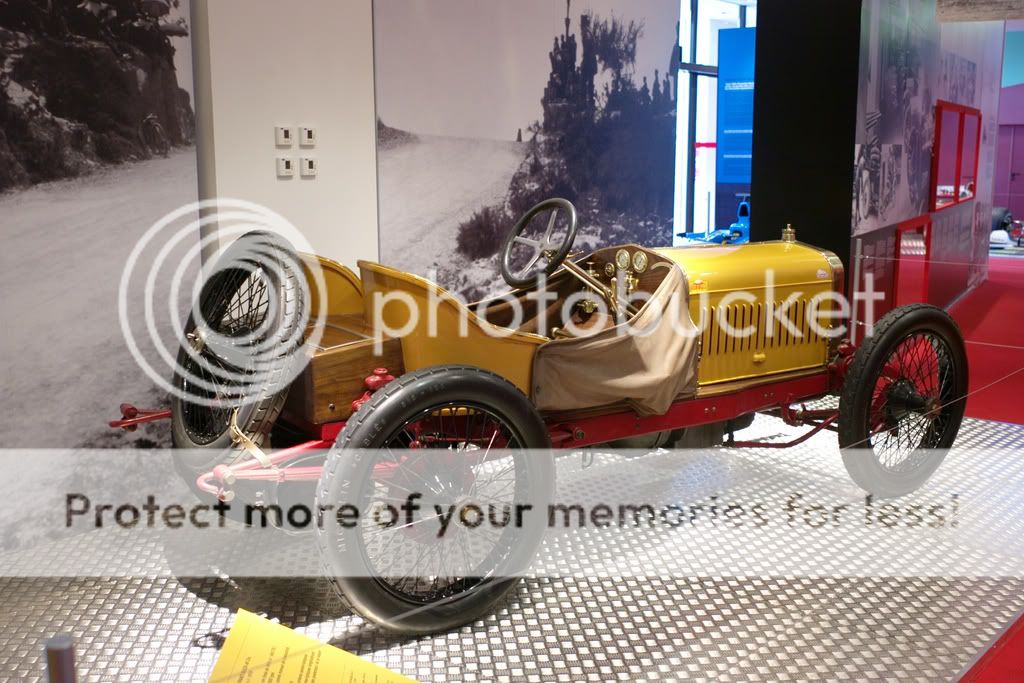From Borgeson The Classic Twin Cam Engine Page 43 to 47.
One of the scions of the house of Peugeot was Armand, born in 1849- As a young engineer working in England he witnessed the beginnings of the bicycle
revolution there. He saw its potential very clearly and in 1885 persuaded the directors of the family business — the Societe Peugeot Freres — to undertake
bicycle manufacture. Starting at the very time of the birth of the Daimler lightweight engine, Peugeot began building pedal-propelled tricycles and
quadricycles as well as two-wheelers. Armand Peugeot became interested in motorisation and, in collaboration with the : pioneer Serpollet, he built a few
steam-powered tricycles. He exhibited one of these at that crossroads of machine civilisation, the Exposition Universelle in Paris in 1889. It was there
that he was able to observe in operation one of the very first canots automobile, a launch powered by one of the improved Daimler narrow-angle V-rwin
engines. It persuaded him of the superiority of petrol over steam for vehicular use. The machine-tool manufacturing firm of Panhard et Levassor had
acquired the French rights to Daimler's patents with the intention of producing motor vehicles as well as engines alone. Panhard et Levassor needed a
source for everything but the power unit and turned to bicycle manufacturer Peugeot. During that same year of 1889 Messrs. Daimler and Levassor together
drove a Daimler car from Cannstat to visit Armand Peugeot at his home at Valentigney, due east of Paris and not far from the Franco-Swiss border towns of
Belfort and Basel. The agreement by which Peugeot became P & L's supplier was consummated, along with a second one which permitted the Peugeot company to
manufacture automobiles on its own behalf, obtaining its French-built Daimler engines from Panhard et Levassor in Paris. In 1891 Peugeot produced its first
Daimler-engined quadricycles. The following year the management of the firm passed to Armand and his three cousins Pierre, Robert, and Jules and its name
was changed to the Ste. des Fils de Peugeot Freres. In 1894 the world's first formally organised motor race was held between Paris and Rouen, a distance of
79 miles, and, following the large and victorious steam rig of Albert de Dion, little Peugeots finished second and third. From the petrol-engine standpoint
Peugeot was the winner and its overnight fame was so great that the company was able to sell 40 cars that year. It is worth noting that among the horde of
cyclists who pedalled along to spectate was Robert Peugeot, aged 25. Another eye-witness to this historic contest was Papa Daimler himself. Armand Peugeot
devoted increasing amounts of his time and energy to the automotive side of the firm's business, convinced that an enormous future lay in that direction.
His cousins worried about the encroachment of the new-fangled horseless carriage upon their capacity to produce goods of risk-free general acceptance.
There was a rift and in 1896 Armand left the company and founded a new one which he named the Ste. des Automobiles Peugeot. He offered a large line, from
small cars to heavy trucks, and prospered. In 1899 the courage was found at the other company, Peugeot Freres, to add motorcycles to the two-wheel line of
products. By 1905 it was clear to almost anyone that the automobile was indeed replacing the horse and the cousins elected to enter the light-car
manufacturing field, introducing a pair of charming one cylinder two-seaters in 1906. They gave them the brand name of Lion, the heraldic Lion of Belfort
having been the firm's registered trade mark for its line of hand tools since 1858 and of its bicycles since 1889- It was the Lion marque which, under
the administration of Robert Peugeot, played one of the leading roles in the Coupe de I'Auto series and which mothered The Charlatans. Press and public
preferred to call the cars Lion Peugeots, creating a confusion which still reigns today. To compound the ambiguity the breach which had separated the two
houses was healed and in 1910 they merged to form the new Ste. Anonyme des Automobiles et Cycles Peugeot. But the Lion marque was kept alive until the final
liquidation of its inventory during the war. The famous Bugatti-designed Bebe Peugeot, by the way, was born not a Peugeot but a Lion.
Having described in Motoring Racing Memories how Jules Goux had "guaranteed to design, build and prepare a set of Grand Prix racing cars at £4,000 each,
all the work to be done outside the factory, and accounts to be rendered only to the head of the company" Bradley continued: 'Agreed,' said M. Robert
Peugeot. 'At Suresnes we have workshops which have been used by M. Verdet for experiments on the Rhone engine. Rhone is going to link up with Gnome to
make the Gnome & Rhone aviation engine; thus the shops at Suresnes can become your headquarters.' According to the Georgano Encyclopedia, Rossel was a
Peugeot engineer who in 1910 formed a joint company with Peugeot to make aero engines. The Ste. des Constructions Aeriennes Rossel-Peugeot had its shops
in Suresnes, on the far edge of the Bois de Boulogne, just west of Paris. On page 469 of what had just been renamed La France Automobile et Aerienne for
1910 an article on the new Rossel-Peugeot engine begins: "Aviation meetings do not only have the result of causing progress in aeroplane construction,
increasing the rapidity of their takeoff and of their speed, but they also very forcibly stimulate the zeal of our engine builders.
"Who would doubt that there are a good fifty aero engines already running? The meetings at Rouen and Rheims only had ten different types to show us,
but many others are undergoing tests, final tuning, or are under construction." Robert Peugeot and company had lost no time in getting in on the ground
floor of the aeroplane-engine business, but Bradley's facts were garbled. The company which made the Le Rhone engine was not founded until September 1912,
nor did its relationship with Gnome begin before June 1914. Apparently Peugeot dropped Rossel and his ideas for rotary engines, while Louis Verdet saw
what was wrong with them and went off to create Le Rhone.Verdet, a native of Lyons, was one of the two engineers responsible for the Lion racing cars.
He had distinguished himself with the creation of the 80 X 280(3.5 to one stroke/bore ratio!) twin cylinder machine which had made its debut in the
Coppa Florio delle Vetturette of 1909. The engine had eight valves and enabled Giuppone to finish second in that brutal, 185 mile edition of the
Targa Florio. These engines were fabricated in the Rossel shops and the cars employing them were built and headquartered there. Source: Yvelin.
The car which took first place in the 1909 Sicilian race, then first in the Copa Catalunya in Spain, then first in the Coupe de I'Auto and usually driven
by Goux, dated from the previous year and was powered by a 15° V-twin, designed in the pure old Gottlieb Daimler tradition and in the new Peugeot motorcycle
tradition by engineer Gratien Michaux. This veteran also had to his credit the design of the original in-house Peugeot engine, the horizontal, parallel
twin which replaced Daimler engines in Peugeot cars in 1897. His Lion racing machines were designed and built at the factory in Beaulieu, a small community
in the departement of the Doubs, literally within walking distance of the Peugeot family's other considerable properties in Audincourt, Montbeliard, Sochaux,
and finally Valentigney, where both Goux and Boillot were born. It must indeed have come as a shock to engineers Michaux and Verdet, whose racing
voiturettes were of rather world-beating calibre, when a trio of mere driver-mechanics was brought in and they were told that their services no longer
would be needed in the racing sector. In the caste system of the day manual workers of the sort might speak to an engineer only with great deference.
That they should have ideas and the brashness to express them was unthinkable. I visualise a scenario along these lines: Robert Peugeot and his brothers
had had their chance and has misjudged the automobile.at a time when an important position was open to them on the ground floor of that industry.
From bicycles they did get in on the ground floor of the motorcycle industry, which was fast becoming as appreciable to them as possession of a large
chunk of the ground floor of the bicycle industry already was. Their motorcycle experience had taught them about small engines and getting performance out
of them. This enabled them to make a belated but well-grounded start in automobiles, at which they were doing well. Now was the historic moment to stake
out a ground floor position in aero engines. The Verdet/Rossel adventure had been a deception, and time was rushing past. Comes earnest, honest Jules Goux,
a young man of confidence, whose family has been in the service of the Peugeot family for a very long time. He is a patient, serious, dependable worker.
He is seconded — or, rather, dominated — by that scandalously handsome, charming, intelligent Boillot boy, full of ambition, dynamism, and the power to
organise and command. And their young Italian friend, whose clever head is full of Hispano-Suiza's methods and tricks. They have an idea for something
brand new, and it really looks as though it should work. If it does, the company will know how to move with it. With the purse strings in our hands we
can always impose our own better judgement. They are a good and capable team and with any luck at all the publicity from racing will amortise the
investment soon enough. And with a little more luck. . . millions! En avant\ What form did the new relationship take? Until now the trio had been on the
Lion payroll, working as test drivers and mechanics when not required for racing. But now they were contracting to build a series of cars for a fixed fee
of £4,000 per unit — $20,000 1911 gold dollars. By what factor do you multiply that sum to get the equivalent in today's money?
Robert Peugeot really was looking for something. As we have seen, he had made a similar deal with another bright young fellow who was no engineer but who
was bristling with original ideas for high performance cars and engines. Name of Bugatti. Guarantee them both the agreed-upon price for one prototype and
let results speak for themselves. The winner then becomes a contractor — a private constructor of racing cars and the operator of a private racing stable,
working under contract to Peugeot. Such arrangements were to become commonplace in the future — Scuderia Ferrari to name one well-known example. This one
was what Rene Thomas always referred to formally as L'Equipe Boillot, doing a job for Peugeot. All inputs are clear on the point that Boillot was the
organisational brain and the boss. They agree that Zuccarelli was a rich source of ideas. No contemporary source suggests that Goux contributed any ideas
at all. And Ernest Henry? He was hired by Boillot as an engineering draftsman. Later he would be referred to in the press as "the great Peugeot engineer",
but he really worked for L'Equipe Boillot. If he ever was on the direct Peugeot payroll it was probably after the outbreak of war, when the equipe broke
up and he began drawing up a V8 aero engine for Peugeot to look at and reject but perhaps to file for future reference. To my knowledge the contemporary
press ignored the very existence of Ernest Henry prior to 1915, when the Charlatan epic was nothing but a radiant memory. We have, happily, an evaluation
of Henry by an authority who is eminently competent. In his article on Albert Morin, Harry Mundy wrote in the Autocar for 25 September 1969:
"W. F. Bradley has always given credit to the three drivers as being primarily responsible for the 1912—1914 Peugeots: referring to Henry as 'a draftsman,
nothing more'. The dividing line between a draftsman and a designer is a very thin one indeed. A man who lays out the initial scheme on paper, stresses
the various parts if only to relatively simple formulae, and produces drawings for a component such as a cylinder head, with the complicated water
passages properly developed so that the foundry can produce sound castings is, like Henry, a first-class designer."
No one was around to document the beginnings of the epic, and they are thoroughly hazy. One immutable point of reference is the neatly round displacement
of the original GP car. It was Yvelin who found that The Charlatans began their system of nomenclature by calling this model the L76, for its perfectly
round 7.600 litres of displacement. It is the product of a bore and stroke of 110 X 200mm.
1911 must have been a pivotal year at Peugeot.
http://gallica.bnf.f...=peugeot.langENhttp://gallica.bnf.f...=peugeot.langEN
Edited by fixedhead, 21 June 2011 - 15:43.



